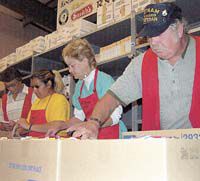| Carbon County Food Bank workers Bob Cook, Ruby Bryner, Richelle Herrera and Moses Gallegos fill boxes for local residents. The food bank serves 350 qualified families per month and relies on public donations. |
Hunger is a mounting problem which plagues Carbon County, Utah and the United States.
According to the Utah Food Bank, more than 343,000 people residing at locations across the state worry about where their next meal will come from.
In Carbon County, the local food bank provides assistance to many poverty stricken residents.
In fact, according to food bank director Jackie Butkovich, the facility located in Price serves 350 families each month.
The only way that the food pantry may provide the goods is through donations from the local community.
With the recent hurricanes hitting the Gulf Coast, food banks across the country have jumped in to assist the victims of the natural disasters.
Utah food banks are no different.
In fact, the Utah Food Bank reports that the state agency has already sent supplies to Texas and has assisted at Camp Williams in feeding the evacuees.
But responding to disaster situations occurring outside of Utah tends to weaken food supply for state residents and, therefore, donations are crucial.
“We haven’t really been affected by the hurricanes. The only times we do struggle are after the mail carriers and the Boy Scouts food drives. We are, however, in somewhat of a dry spell just before the holidays,” explained Butkovich.
Last year, the Utah Food Bank collected and distributed more than 22 million pounds of food to residents across the state.With the demand increasing yearly, the supply must also increase.
Carbon County residents may assist local citizens by dropping off non-perishable items at the local food bank located in south Price.
Some items that are accepted include tuna fish, spaghetti sauce, peanut butter, powdered milk and pasta.
Butkovich indicated that fresh produce from residents’ gardens is also accepted as long as the items are brought to the food pantry Tuesday through Thursday.
Dropping off the produce from Tuesday to Thursday will allow food bank workers to hand out the fresh items the same day as donated.
All food will be distributed to local residents who meet eligibility requirements and will provide nutrition to hungry adults as well as children.
According to Utah Food Bank data, the childhood poverty rate in the state is 11.5 percent.
The statistic means that 87,000 Utah children are living in poverty, according to the U.S. Census Bureau.
The state food bank also pointed out that one in five Utah children go hungry an average of seven days per month.
By donating regularly to the Carbon County Food Bank, local residents can help put an end to hunger for children in the community.
Although many feel sympathetic towards children, the truth is that residents of all ages go hungry on a regular basis if there is not enough income to purchase food. The elderly are also a group of local residents who suffer from poverty and hunger.
According to a 2003 U.S. Census Bureau study, more than 8,000 senior citizens in Utah live in poverty. Because this number is so high, the local food bank provdes food for qualified seniors.
A donation to the food bank may supply several families with much needed food and even more needed support.

